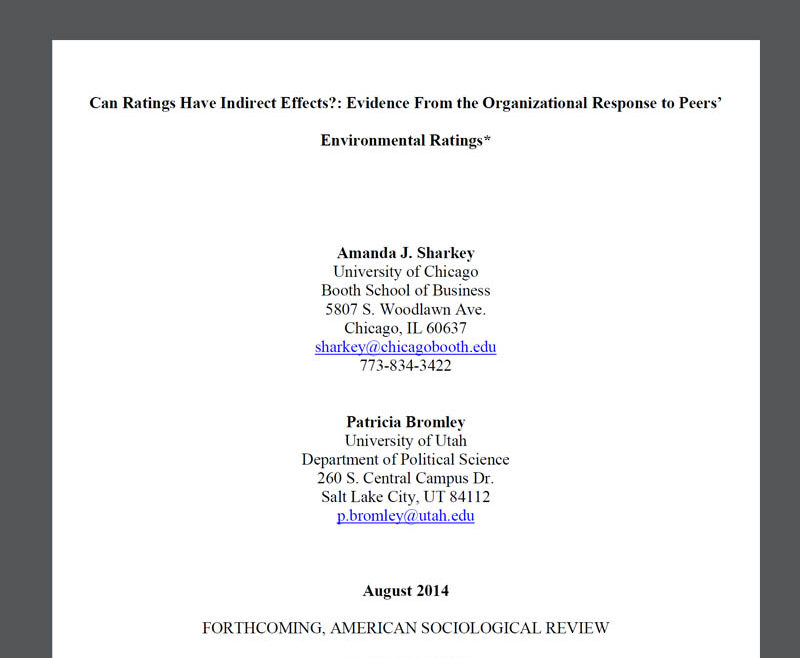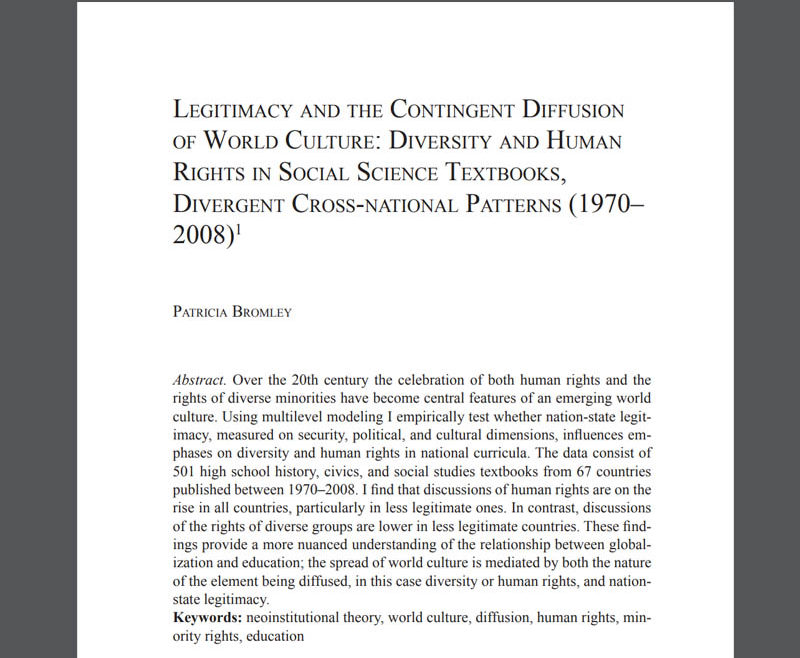Human Rights, Diversity & Sustainable Development
Human Rights, Diversity & Multiculturalism
Climate Change in TX & CA History Textbooks
http://www.patriciabromley.com/wp-content/themes/osmosis/images/empty/thumbnail.jpg 150 150 TrishAdmin TrishAdmin http://2.gravatar.com/avatar/e215c03fe78483cee137e5421dec4d4f?s=96&d=mm&r=gContent Analysis of Textbooks via Natural Language Processing: Findings on Gender, Race, and Ethnicity in Texas US History Textbooks
http://www.patriciabromley.com/wp-content/themes/osmosis/images/empty/thumbnail.jpg 150 150 TrishAdmin TrishAdmin http://2.gravatar.com/avatar/e215c03fe78483cee137e5421dec4d4f?s=96&d=mm&r=gIndividual and Collective Social Justice Education: Comparing Emphases on Human Rights and Social Movements in Textbooks Worldwide, 1950-2010
http://www.patriciabromley.com/wp-content/themes/osmosis/images/empty/thumbnail.jpg 150 150 TrishAdmin TrishAdmin http://2.gravatar.com/avatar/e215c03fe78483cee137e5421dec4d4f?s=96&d=mm&r=gThe Pyramid of Nonprofit Responsibilities: The Institutionalization of Organizational Responsibility Across Sectors
http://www.patriciabromley.com/wp-content/themes/osmosis/images/empty/thumbnail.jpg 150 150 TrishAdmin TrishAdmin http://2.gravatar.com/avatar/e215c03fe78483cee137e5421dec4d4f?s=96&d=mm&r=gHuman Rights as Cultural Globalization: The Rise of Human Rights in Textbooks, 1890-2013.
http://www.patriciabromley.com/wp-content/themes/osmosis/images/empty/thumbnail.jpg 150 150 TrishAdmin TrishAdmin http://2.gravatar.com/avatar/e215c03fe78483cee137e5421dec4d4f?s=96&d=mm&r=gEducation for Global Citizenship and Sustainable Development in Social Science Textbooks.
http://www.patriciabromley.com/wp-content/themes/osmosis/images/empty/thumbnail.jpg 150 150 TrishAdmin TrishAdmin http://2.gravatar.com/avatar/e215c03fe78483cee137e5421dec4d4f?s=96&d=mm&r=gCan Ratings Have Indirect Effects?: Evidence From the Organizational Response to Peers’ Environmental Ratings.
http://www.patriciabromley.com/wp-content/uploads/2017/11/CanRatings.jpg 800 800 TrishAdmin TrishAdmin http://2.gravatar.com/avatar/e215c03fe78483cee137e5421dec4d4f?s=96&d=mm&r=gOrganizations are increasingly subject to rating and ranking by third-party evaluators. Research in this area tends to emphasize the direct effects of ratings systems that occur when ratings give key audiences, such as consumers or investors, more information about a rated firm. Yet, ratings systems may also indirectly influence organizations when the collective presence of more rated peers alters the broader institutional and competitive milieu. Rated firms may be more responsive to ratings systems when surrounded by more rated peers, and ratings may generate diffuse or spillover effects even among firms that are unrated. We test these arguments by analyzing how rated and unrated firms change their pollution behavior when more firms in their peer group are rated on environmental performance. Results indicate that the presence of more rated peers was often associated with emissions reductions. However, this relationship varies by the whether a firm was rated, whether the rating was positive or negative (if rated), and, often, features of the competitive and regulatory environment.
Legitimacy and the Contingent Diffusion of World Culture: Diversity and Human Rights in Social Science Textbooks, Divergent Cross-National Patterns (1970-2008)
http://www.patriciabromley.com/wp-content/uploads/2017/11/Legitimacy.jpg 800 800 TrishAdmin TrishAdmin http://2.gravatar.com/avatar/e215c03fe78483cee137e5421dec4d4f?s=96&d=mm&r=gOver the twentieth century the celebration of both human rights and the rights of minorities have become central features of an emerging world culture. Although related in some respects, ideas of human and minority rights differ in their fundamental conception of society as made of either heterogeneous social
groups or universally equivalent individuals. I posit that the contradiction between universality and diversity in world culture leads to divergent patterns of diffusion into nation-states and provide evidence of this trend. The data consist of 523 high school social science textbooks from 74 countries published
between 1970 and 2008 coded for content relevant to human and minority rights. Using multilevel modeling, I find that increases in minority rights discussions occur mainly in stable democracies, in contrast to a worldwide rise in discussions of human rights. These findings contribute to studies of globalization, education, and minority and human rights by documenting the spread of global models of citizenship into national education systems and identifying limits to the diffusion of global principles.
Read the article here:
https://journals.library.ualberta.ca/cjs/index.php/cjs/article/view/17001
Holocaust Education and Human Rights: Holocaust Discussions in Social Science Textbooks Worldwide, 1970-2010.
http://www.patriciabromley.com/wp-content/themes/osmosis/images/empty/thumbnail.jpg 150 150 TrishAdmin TrishAdmin http://2.gravatar.com/avatar/e215c03fe78483cee137e5421dec4d4f?s=96&d=mm&r=g- 1
- 2


